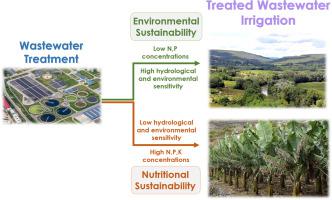Science of the Total Environment ( IF 8.2 ) Pub Date : 2021-09-17 , DOI: 10.1016/j.scitotenv.2021.150387 E Shtull-Trauring 1 , A Cohen 2 , M Ben-Hur 1 , M Israeli 2 , N Bernstein 1

|
Treated wastewater (TWW) is increasingly used for agricultural irrigation, and often contain higher concentrations of the major plant nutrients N, P, and K than freshwater, reducing the need for agricultural fertilization. However, excessive inputs of nutrients to cropping systems can be harmful to crops and the environment. The present study developed and employed six novel indices to assess the sustainability of TWW-irrigation and spatio-temporal trends in NPK loads to TWW-irrigated fields. Three indices relate to regional analysis of TWW-irrigation sustainability: the ‘Environmental sustainability’ index measures the TWW compliance with environmental irrigation standards; a ‘Nutritional sustainability’ index assesses whether the TWW satisfy crop fertilization requirements; a ‘Basin nutrient surplus’ index measures river-basin loads of N or P above allowed levels. Three additional indices assess the environmental impact, potential loss of nutrients and fit of a given TWW for fertilization recommendations. We employed these indices to analyze a decade-long high spatio-temporal resolution data of TWW quality from Israel on a basin scale, for six TWW-irrigated plantation crops. The results reveal that in high-sensitivity hydrological areas, TWW is generally above the environmental standard for N and P; the TWW with lowest nutrient content is irrigated in low-sensitivity areas, leading to a reduced potential for utilization of nutrients in TWW. While the N irrigation standard (25 mg L−1) does not exceed the nutritional requirements of most analyzed crops, the P standard (5 mg L−1) results in excess fertilization for all analyzed crops. Therefore, environmental and nutritional sustainability of TWW-irrigation can be increased by diverting high-quality TWW to high-sensitivity areas and vice versa. Furthermore, development of local environmental standards will allow maximizing TWW NPK utilization in low- sensitivity areas, increasing nutritional sustainability. The indices presented in this study provide a tool to help maximize the nutritional benefits of TWW while minimizing its environmental impact.
中文翻译:

处理过的废水灌溉中的 NPK:区域尺度指数,以最大限度地减少环境污染和优化作物营养供应
处理过的废水 (TWW) 越来越多地用于农业灌溉,并且通常比淡水含有更高浓度的主要植物养分 N、P 和 K,从而减少了对农业施肥的需求。然而,向种植系统过度输入养分可能对作物和环境有害。本研究开发并采用了六个新指标来评估 TWW 灌溉的可持续性和 TWW 灌溉田的 NPK 负荷的时空趋势。三个指数与 TWW 灌溉可持续性的区域分析相关:“环境可持续性”指数衡量 TWW 对环境灌溉标准的遵守情况;“营养可持续性”指数评估 TWW 是否满足作物施肥要求;“流域养分过剩”指数衡量河流流域中氮或磷超过允许水平的负荷。三个额外的指数评估环境影响、养分的潜在损失以及给定 TWW 是否适合施肥建议。我们使用这些指数来分析以色列在流域尺度上对六种 TWW 灌溉种植园作物的 10 年高时空分辨率数据。结果表明,在高敏感水文区,TWW氮、磷普遍高于环境标准;在低敏感性地区灌溉养分含量最低的 TWW,导致 TWW 养分利用潜力降低。而 N 灌溉标准(25 mg L 养分的潜在损失和给定 TWW 的适合施肥建议。我们使用这些指数来分析以色列在流域尺度上对六种 TWW 灌溉种植园作物的 10 年高时空分辨率数据。结果表明,在高敏感水文区,TWW氮、磷普遍高于环境标准;在低敏感性地区灌溉养分含量最低的 TWW,导致 TWW 养分利用潜力降低。而 N 灌溉标准(25 mg L 养分的潜在损失和给定 TWW 的适合施肥建议。我们使用这些指数来分析以色列在流域尺度上对六种 TWW 灌溉种植园作物的 10 年高时空分辨率数据。结果表明,在高敏感水文区,TWW氮、磷普遍高于环境标准;在低敏感性地区灌溉养分含量最低的 TWW,导致 TWW 养分利用潜力降低。而 N 灌溉标准(25 mg L TWW 一般高于 N 和 P 的环境标准;在低敏感性地区灌溉养分含量最低的 TWW,导致 TWW 养分利用潜力降低。而 N 灌溉标准(25 mg L TWW 一般高于 N 和 P 的环境标准;在低敏感性地区灌溉养分含量最低的 TWW,导致 TWW 养分利用潜力降低。而 N 灌溉标准(25 mg L-1 ) 不超过大多数分析作物的营养需求,P 标准 (5 mg L -1 ) 导致所有分析作物施肥过多。因此,通过将高质量的 TWW 转移到高敏感地区,反之亦然,可以提高 TWW 灌溉的环境和营养可持续性。此外,当地环境标准的制定将允许在低敏感性地区最大限度地利用 TWW NPK,提高营养可持续性。本研究中提出的指数提供了一种工具,可帮助最大限度地提高 TWW 的营养价值,同时最大限度地减少其对环境的影响。









































 京公网安备 11010802027423号
京公网安备 11010802027423号